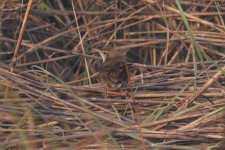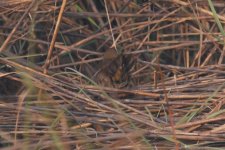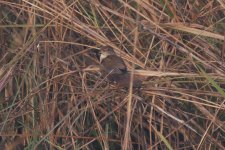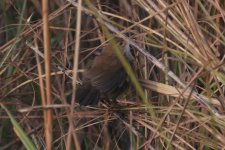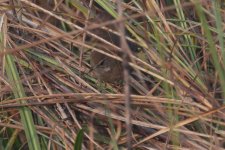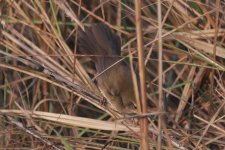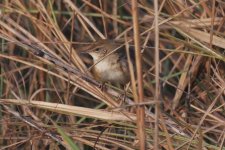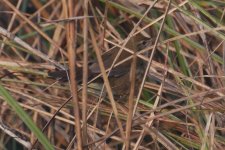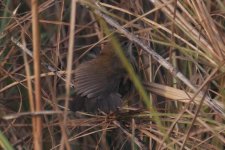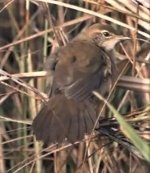This bird still remains a mystery. I have received varying feedbacks from different experts. I have decided to keep it is simply as Locustella sp. for the time being.
///////////////////////////////////////////////////////
"My feeling is that this is one of the longer-tailed 'Bradypterus', the proportion of the tail length to the body appears too long for Spotted & Baikal Bush.
The upperparts of Brown Bush (luteoventris) should appear warmer toned than this bird shows, the undertail-coverts are uniform and it lacks a supercilium. On this basis I'm ruling it out.
The various races of Russet Bush (mandelli) should appear darker above and below, and the supercilium is indistinct and doesn't extend beyond the rear of the eye. . Also, mandelli should have broad conspicuous pale tips to the undertail-coverts - almost crescent shaped (as do Spotted & Baikal Bush) - which this bird lacks - on this bird the pale area is restricted to the very tip of the undertail-coverts and doesn't form a crescent.
The feature that I picked up on from the photos is the white lower edge to the eye that joins with the supercilium in front of the eye - forming a whitish Vee, broadest at the eye (with a dark loral spot) and coming to its apex towards the bill base. Not every picture shows this but enough do to make me think it's real rather than an artifact of the photo at an instant in time. So I'm leaning towards Chinese Bush (tacsanowskius) which shows this feature - if you have Reed & Bush Warblers see p. 177, particularly the lower two images. The prominence and extent of the supercilium varies, but on some individuals it extends behind the eye as in this bird.
The pale tips to the undertail-coverts also fit Chinese Bush as they are solid rather than crescentic in shape - though usually more extensive than this bird shows - perhaps their prominence/extent is age related?
If you know of other images of this bird, or high res images that may show greater detail, I'd be interested to see them."
-- Peter Kennerley (UK-based author of Reed and Bush Warblers).
///////////////////////////////////////////////////////
"It should be noted Chinese, like Baikal, is a long distance migrant so likely more prone to vagrancy/extralimital records. But in any case both would be aware of the possible significance in terms of location.
I have copied Peter's comments to Phil."
-- Grahame Walbridge (England)
///////////////////////////////////////////////////////
"Re the Indian Bradyopterus you shared, there did not seem to be a clear view of under tail coverts. Based on breast colouration, absence of greyness around head, Spotted should be ruled out, yet tail too long for davidi, so I assume Brown (although not as obviously yellowish on the lower mandible as some Brown). But that is what I would make it."
-- Phil Round (Thailand)
///////////////////////////////////////////////////////
"I agree with Peter on the Chinese Bush Warbler identification.
However, although I'm familiar with Baikal, I have had very limited experiences on Spotted and Chinese Bush Warblers as they are both rare in Thailand."
-- Wich'yanan L. (Thailand)
///////////////////////////////////////////////////////
"... look like Spotted/Baikal Bush Warbler (I'm leaning more towards Spotted BW). Check out the undertail coverts, you wouldn't see such dark undertail coverts with pale tips like that in Chinese BW. In Chinese BW, the undertail coverts are very pale sandy brown with slight contrasting broad white tips (but in a quick glance, you barely see the contrast). Overall body plumage of Chinese BW is also much paler, more sandy brown than this. Check out these photos of Chinese BW for comparison. Note overall colouration and undertail patterns.
"
-- Ayuwat Jearwattanakanok (Thailand)
///////////////////////////////////////////////////////
"I am in total agreement with Ayuwat. I see nothing that points towards Chinese in any photo. Chinese is such a paler faced bird, larger billed, paler underparts, and most importantly, the under tail coverts are wrong for Chinese. I don’t think the tail is long enough either.
Silent spotted and baikal are a very difficult species pair, as both show variable throat markings, where the extremes can be identified but those with little markings are much more tricky, and playback would resolved the issue.
Given that Spotted is much more numerous than Baikal in Northeast India, I’d label them all as Spotted until told otherwise - no feature discounts Spotted."
-- James Eaton (England)
